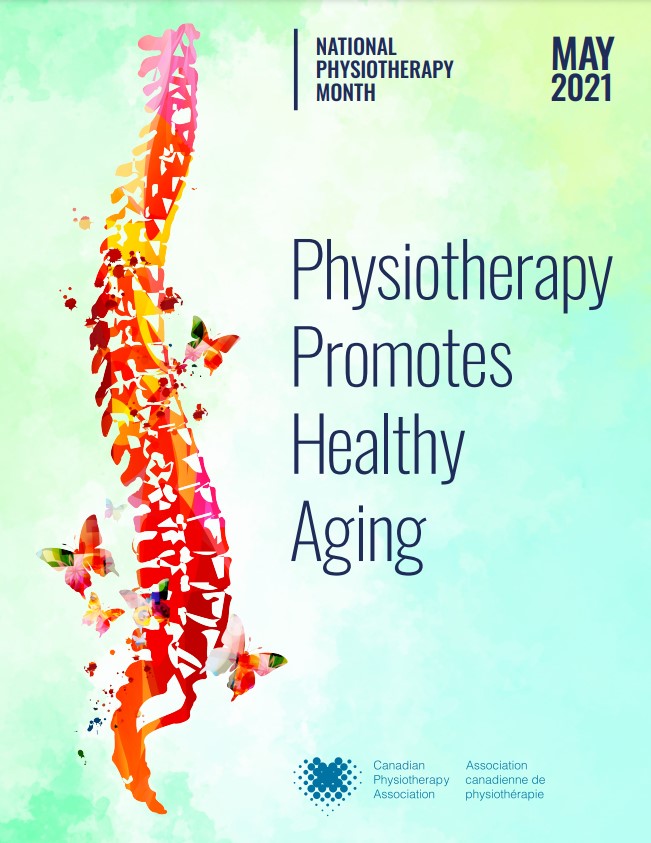
May is National Physiotherapy Month! This year, we are highlighting the many ways our profession can enable and support healthy aging. “From helping Canadians recover from illness to helping improve the flexibility, strength, and balance older adults need to remain independent and mobile, physiotherapy plays a key role in healthy aging. The pandemic has made the benefits of physiotherapy even more obvious – not just for older adults. Physiotherapy can help Canadians maintain and improve their physical wellbeing and manage and prevent injury and illness in all of us as we age. We invite you to celebrate this month with us as we highlight how physiotherapy promotes healthy aging and is your essential partner for optimizing health” (Canadian Physiotherapy Association).
Cadiorespiratory exercise is important at every age and is oft-neglected as we age. With the arrival of warmer temperatures and longer daylight hours combined with the continued closure of gyms and indoor recreational centres, we need to explore options for a safe outdoor activity. Perhaps you have already been walking all year and you need a different activity to shed some of that extra pandemic weight?

What about cycling? The health benefits of cycling have long been established in the research literature. Studies have shown that regular cycling can improve and maintain cardiovascular health, improve lung function and help manage a healthy weight (1). Moreover, daily commuter cycling has been associated with decreased risk of all-cause mortality among middle aged to elderly individuals (1). Cycling is also beneficial for managing osteoarthritis in the hips and knees (2), and even in some neurological disorders, such as Parkinson’s (3) and stroke (4). It even has been shown to reduce depression-like symptoms in adults (5).
If you are struggling with a pre-existing health condition, be certain to consult with a health professional prior to engaging in any cardiovascular activity. Also, if you are new to cycling and do not yet own a bike, here are some important questions to consider prior to your purchase.
We asked Alex Stieda, a former professional cyclist, a former Olympian and who was the first North American to win the prestigious Tour de France Yellow Jersey, his advice on the questions to be asked prior to a bike purchase.
Alex says: “When purchasing a bicycle, a reputable bike shop should ask you to consider the following questions to help you find the most suitable bike for your current needs and ability:
- What kind of riding do you plan on doing? Road? Mountain?
- How frequently will you be riding and what distances?
- What is your riding experience?
- What is your budget?
A proper fit is as important as the choice of a bike. This includes saddle fitting and hand position as well as choosing the right accessories like a proper helmet, cycling short pads and cycling shoes for more advanced riders. This is why choosing a good bike shop is so critical.”
Are you considering cycle commuting to and from work? Gilbert Davis is a long-time friend to our Clinic and is a cycling enthusiast who bike commutes to and from work and is an ultra-runner here in Edmonton. We asked his advice on bike commuting:

1. Expect the unexpected: Every ride will be different and you’ll need to adapt and problem solve. You never know when the weather forecast will be off by 10 degrees or you get a flat tire in a remote area. But don’t fret, you’ll learn what gear you need from these experiences and you will get better at preparing over time.
2. Enjoy it! It’s a beautiful world out there and you will see and notice way more of it being on a bike.
3. It will make you happier. It’ll also make you more physically fit, but the lesser known benefit is that all that activity will improve your mental health too.
4. Don’t stress about how long it takes. If you’re commuting it’s important to remember you’re replacing inactive time in a car with more active time outside. So even if it takes twice as long you’re getting more benefit.
5. It’s getting popular, which means better facilities. Many worry about showing up to work sweaty, but more and more workplaces have improved bike lockups, locker rooms or even showers. Same goes for stores and restaurants. There’s even an ever growing bike network to give you a safe place to ride.
My favorite place to ride varies depending on what I’m riding. If I’m on my road bike, the NE Anthony Henday to Quarry has a new and ripping path right alongside the river. It’s hidden and doesn’t get much traffic. If I’m on my mountain bike, then I really like the trails called Flat Pete and Flatter Pete in Oleskiw. Not hilly but lots (I mean a lot) of turns. If I’m fat biking, then the singletrack and double wide trails in Mill Creek are fantastic. They get lots of traffic so they are good for biking in the middle of winter. When I am commuter biking, cruising the bike lanes downtown and in Strathcona is a great way to tour coffee shops, bakeries and farmers markets. You can fuel as you ride!”
As you can see, regardless of your experience, cycling is a low-impact activity that can be safely enjoyed by people of all ages and levels of physical skill. Whether you choose to mountain bike, road cycle, or even go for a leisurely ride in a park with a trike, you will reap its many health benefits. Many of us have been cooped up inside during the winter months for too long…it is time to get out and start cycling!
Submitted by Georgi Trifonov and Albert Chan. We thank Alex Stieda and Gilbert Davis for their invaluable contribution.
References:
1) Oja, P., Titze, S., Bauman, A., de Geus, B., Krenn, P., Reger‐Nash, B. and Kohlberger, T. (2011), Health benefits of cycling: a systematic review. Scandinavian Journal of Medicine & Science in Sports, 21: 496-509. https://doi.org/10.1111/j.1600-0838.2011.01299.x
2) Keogh JW, Grigg J, Vertullo CJ. 2018. Is high-intensity interval cycling feasible and more beneficial than continuous cycling for knee osteoarthritic patients? Results of a randomised control feasibility trial. PeerJ 6:e4738 https://doi.org/10.7717/peerj.4738
3) Chang HC, Lu CS, Chiou WD, Chen CC, Weng YH, Chang YJ. An 8-Week Low-Intensity Progressive Cycling Training Improves Motor Functions in Patients with Early-Stage Parkinson’s Disease. J Clin Neurol. 2018 Apr;14(2):225-233. doi: 10.3988/jcn.2018.14.2.225. PMID: 29629527; PMCID: PMC5897207.
4) David Barbosa, Cristina P. Santos, Maria Martins. The Application of Cycling and Cycling Combined with Feedback in the Rehabilitation of Stroke Patients: A Review. Journal of Stroke and Cerebrovascular Diseases, Volume 24, Issue 2, 2015, Pages 253-273, ISSN 1052-3057, https://doi.org/10.1016/j.jstrokecerebrovasdis.2014.09.006.
5) GULLETTE, ELIZABETH C.D. BA; BLUMENTHAL, JAMES A. PhD Exercise Therapy for the Prevention and Treatment of Depression, Journal of Psychiatric Practice: September 1996 – Volume 2 – Issue 5 – p 263-271
